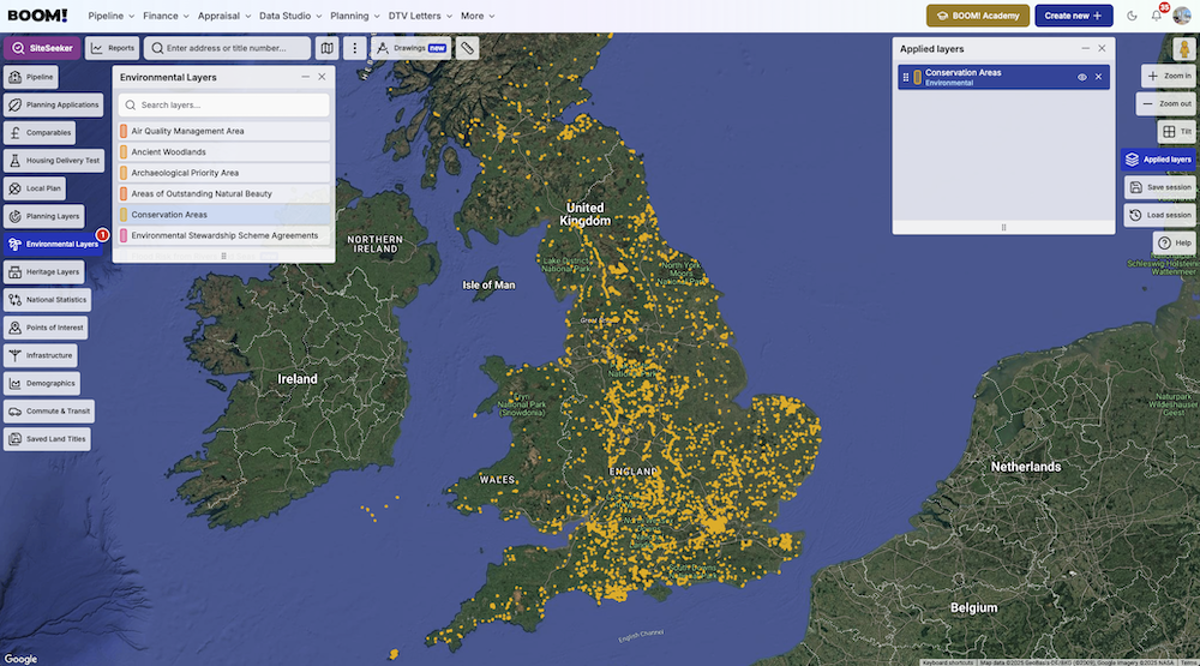Conservation Areas 101: Hidden Opportunities and Pitfalls for UK Developers







Imagine finding the perfect property on a charming old street. Exciting, right? But then reality hits—your dream spot lies inside a conservation area. Suddenly, your plans feel complicated. But what exactly does "conservation area" mean, and how can you navigate the restrictions to still turn a profit?
This guide gives you clear, actionable insights so you'll understand the risks, recognise hidden opportunities, and learn how tech-driven platforms like BOOM! can help you avoid costly mistakes.
What Exactly is a Conservation Area?
A conservation area is a neighbourhood or landscape legally protected by local councils because of its unique historic or architectural value. England has nearly 10,000 conservation areas, covering around 2.2% of the country. So, sooner or later, you'll likely encounter one.
Within these protected areas, local authorities exercise greater control over property developments. Even small changes—such as replacing windows, altering façades, or removing mature trees—often need planning permission. Demolishing or significantly changing a building without consent can result in severe penalties, including hefty fines or even criminal charges.
Why Conservation Areas Matter to Developers
Ignoring conservation regulations can quickly become expensive. For example, one UK developer faced an £80,000 fine for demolishing a Victorian house without permission. Even minor oversights can lead to costly delays, legal fees, or stalled projects.
The bottom line? Conservation rules aren't just guidelines—they're mandatory. Move too quickly without thorough checks, and you risk losing months to rejected applications, or worse, hefty penalties. Most UK councils have at least one conservation area, usually covering popular towns or villages full of charm and character. Councils fiercely guard these areas, so any development must "preserve or enhance" the area's unique character.
Hidden Opportunities in Conservation Areas
But it's not all bad news. Conservation areas can be hidden gems for savvy developers. Why? Because many newcomers shy away, leaving less competition and more room for you to secure undervalued properties.
Homes in conservation areas typically hold their value better—even during market downturns—because people pay a premium for character and heritage. If you're willing to navigate the complexities, you can capitalise on these attractive, stable neighbourhoods. Buyers don't just purchase a home; they buy into a desirable, protected community.
Instead of seeing rules as limitations, view them as selling points. Developing thoughtfully in conservation areas ensures higher-quality projects. Your finished developments blend seamlessly into historic surroundings, making them more desirable and valuable.
Your Conservation Area Success Checklist
Want to successfully navigate these areas? Follow this clear five-step checklist:
1. Do Your Homework Early Before bidding, confirm if your target site is within a conservation area. Tools like BOOM! can quickly highlight protected zones directly in your property search. Early research saves you headaches, money, and unpleasant surprises.
2. Assume You'll Need Planning Permission Conservation areas typically override permitted development rights. Extensions, dormer conversions, even new windows generally require formal planning permission.
Expect longer approval processes and possibly increased costs. Factoring these into your plans early helps maintain project viability. Don’t wait for rejections—prepare thorough, informed applications from the outset.
3. Consult Early with Planners and Locals Engage informally with your council's conservation officer or a heritage consultant early in the process. Ask for advice on designs likely to gain approval.
Listening to local residents helps, too. Communities often passionately protect heritage. Incorporating their feedback (such as retaining historical features) can reduce opposition, transforming potential objectors into supportive allies.
4. Focus on Sensitive Design Your biggest asset? Sensitive, quality design. Hire architects with heritage-site expertise. Proposals should complement—not clash—with historic surroundings.
Clearly detail your commitment to restoring original features, using traditional materials, or seamlessly blending new builds into historical settings. Councils favour developments that visibly enhance local character.
5. Remain Patient and Adaptable Expect conservation-area projects to take longer. Authorities often request design adjustments or impose conditions. Rather than resisting, be adaptable.
This "red tape" ultimately protects your investment, ensuring your project remains appealing and valuable long-term. Maintaining clear, open communication with planners ensures smoother negotiations, faster approvals, and a more successful outcome.
Leverage Data-Driven Tools to Your Advantage

Tech-savvy developers increasingly rely on tools like BOOM! to streamline conservation-area complexities. Instead of manually researching council regulations or confusing maps, BOOM! overlays clear data layers highlighting conservation boundaries, planning constraints, and policy guidelines. Leveraging technology saves time, reduces risk, and helps you confidently secure profitable sites your competitors overlook.
Real-World Success Stories
Consider historic cities like Bath or Edinburgh. Both strictly enforce conservation regulations, yet developers regularly achieve profitable outcomes by respecting heritage. Properties sensitively renovated within these zones frequently command premium prices, rewarding developers who invest extra time upfront into planning and design.
Why You Should Act Now
Conservation areas are only gaining importance as local communities increasingly value heritage preservation. Upcoming regulations in 2025 may simplify minor approvals, but strict overall rules will remain. Learning to confidently handle conservation complexities now positions you ahead of competitors who shy away, opening doors to lucrative, overlooked opportunities.
Delay now, and you risk losing profitable sites—or worse, mistakenly breaching regulations later.
Key Takeaways:
Know the Risks: Conservation rules are serious—ignoring them can be costly.
Spot Hidden Opportunities: Less competition means higher profits for savvy developers.
Start Early: Thorough research upfront saves time and money later.
Design Thoughtfully: Sensitive design helps gain planning approval and adds lasting value.
Use Smart Technology: Platforms like BOOM! simplify navigating complex regulations.
Ready to Unlock These Opportunities?
Instead of seeing conservation areas as risky, view them as a strategic advantage. With the right mindset and technology, these protected areas can significantly boost your profits, allowing you to create developments you're genuinely proud of.
Stop avoiding conservation areas—start leveraging them. Your next successful project might already be waiting for you in one of these charming, protected neighbourhoods.
Get started now or book a call with us to show you how we can help.